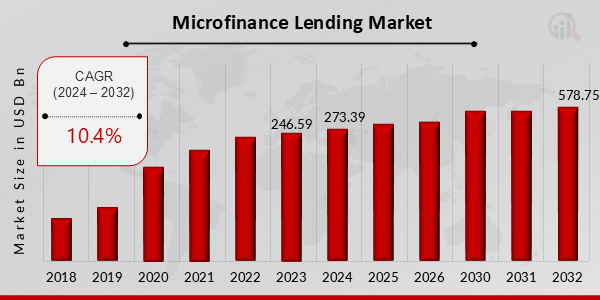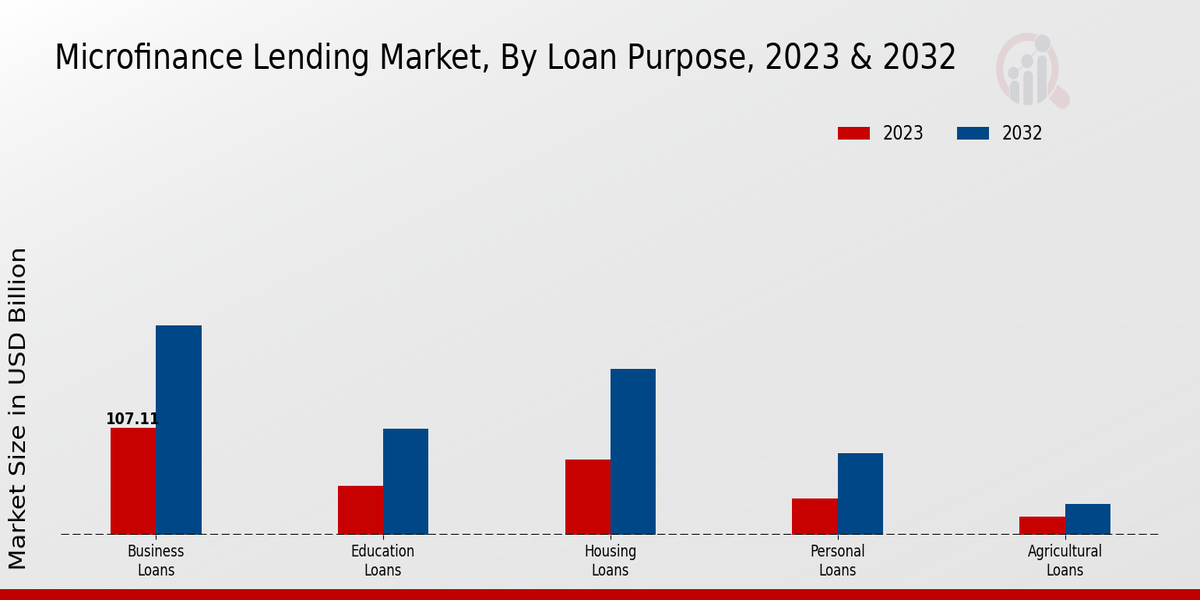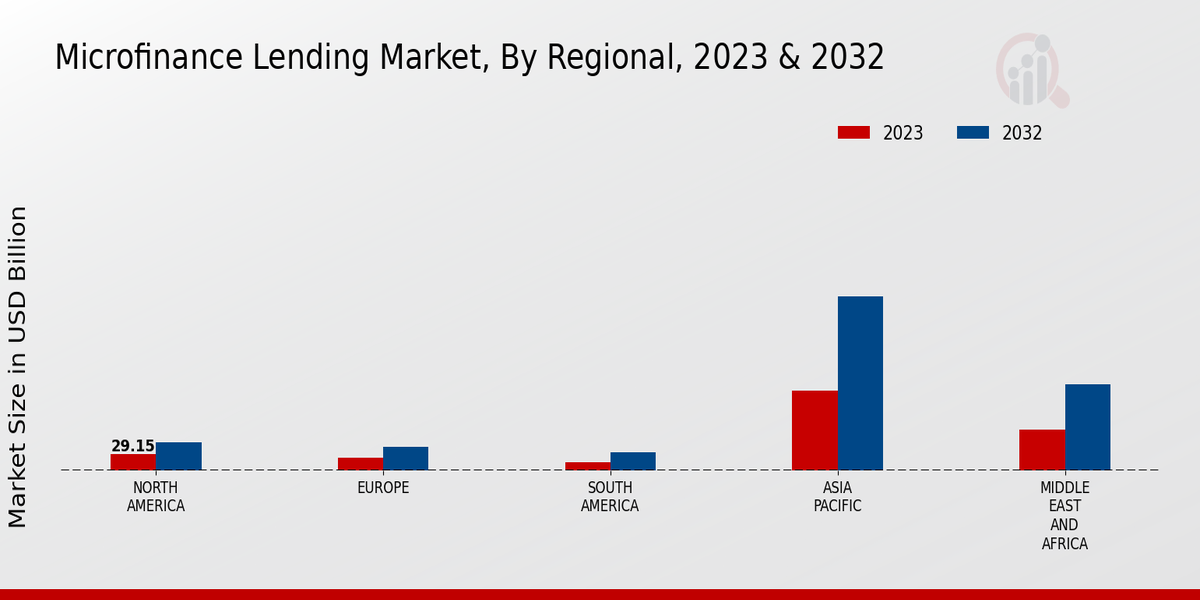Global Microfinance Lending Market Overview
Microfinance Lending Market Size was estimated at 246.59 (USD Billion) in 2023. The Microfinance Lending Market Industry is expected to grow from 273.39 (USD Billion) in 2024 to 578.75 (USD Billion) by 2032. The Microfinance Lending Market CAGR (growth rate) is expected to be around 10.4% during the forecast period (2024 - 2032).
Key Microfinance Lending Market Trends Highlighted
Microfinance lending has surged as a vital instrument for financial inclusion, empowering marginalized populations globally. Key market drivers include rising demand for microloans among small businesses and individuals in developing regions, government initiatives to promote financial access, and advancements in mobile and digital technology.
Opportunities abound in partnerships between microfinance institutions and technology providers, leveraging financial inclusion through mobile apps and agent banking. Additionally, the expansion of microfinance into underserved areas, such as rural communities and microenterprises, offers significant growth potential.
Recent trends reveal the growing adoption of mobile money platforms for microfinance transactions, creating a more convenient and accessible banking experience for customers.
Furthermore, microfinance lending is increasingly integrated with other financial services, such as savings and microinsurance, offering cost-effective and comprehensive financial solutions to low-income individuals and businesses.

Source: Primary Research, Secondary Research, MRFR Database and Analyst Review
Microfinance Lending Market Drivers
Increasing Access to Financial Services
One of the main growth drivers for the Microfinance Lending Market Industry is the increasing need of underserved communities for financial services.
Microfinance institutions are vital organizations that provide necessary access to financial products, such as loans, savings, and insurance for individuals and small businesses, who would otherwise be out of reach for traditional banking. The escalating awareness of microfinance as a whole, alongside governmental support and activities, has driven the demand for such services.
Rising Demand for Microloans
The increasing demand for microloans is another key driver of the Microfinance Lending Market Industry's growth. Microloans are small loans typically offered to low-income individuals and small businesses to help them meet their financial needs.
The rising number of micro, small, and medium-sized enterprises (MSMEs) in developing countries is driving the demand for microloans. These businesses often face difficulties accessing traditional bank loans due to a lack of collateral or credit history.
Microfinance institutions play a vital role in providing microloans to these businesses, enabling them to expand their operations and contribute to economic development.
Technological Advancements
Technological progress is having a considerable impact on the Microfinance Lending Market Industry, with microfinance companies taking advantage of technological solutions to make their services more accessible and convenient.
For example, the whole segment can benefit from the opportunities provided by mobile banking, digital payments or fintech options, with customers making use of these opportunities to access the vast variety of services provided by MFIs.
Clients can manage their accounts, make payments, and repay loans using a mobile phone, and the provider can benefit from overall operational cost reduction.
Microfinance Lending Market Segment Insights:
Microfinance Lending Market Loan Purpose Insights
The Microfinance Lending Market is seeing significant growth, particularly in the Loan Purpose segment, which plays a crucial role in meeting diverse financial needs in various sectors. The market growth is driven by various factors, including increased demand for financial inclusion, rising entrepreneurship, and the essential requirement for affordable education and housing.
Among the notable trends in the Microfinance Lending Market, Business Loans stood out, valued at 60.0 USD Billion in 2023 and expected to reach 126.0 USD Billion by 2032.
This segment dominated the market due to the growing number of small and medium enterprises worldwide seeking capital for expansion, thereby driving the need for microfinance solutions.
Additionally, the Education Loans segment, valued at 40.0 USD Billion in 2023 and projected to attain 85.0 USD Billion by 2032, represented a significant area of focus, as higher education has become increasingly critical for employment opportunities, leading to heightened demand for educational financing options.
Housing Loans were also a cornerstone in the market, holding a valuation of 80.0 USD Billion in 2023, with an expected rise to 164.0 USD Billion in 2032; this reflected the growing necessity for affordable housing solutions in developing regions where traditional financing might be unattainable.
Personal Loans were similarly important, currently valued at 50.0 USD Billion and anticipated to rise to 106.0 USD Billion, as individuals seek financial support for various personal needs such as emergencies, weddings, or healthcare, showcasing the personal finance aspect of micro-lending.
Lastly, Agricultural Loans were valued at 56.56 USD Billion in 2023 and are expected to grow to 115.0 USD Billion, highlighting the significant role agriculture played in economies, especially in rural areas where farmers require support for inputs and innovations.
The segmentation of Microfinance Lending Market data illustrates the diverse purposes for which financing is sought, with each category addressing specific socioeconomic needs and contributing to overall market growth.
The interplay of these segments in the Microfinance Lending Market statistics emphasizes their relevance in promoting financial stability and supporting underserved populations across the globe.

Source: Primary Research, Secondary Research, MRFR Database and Analyst Review
Microfinance Lending Market Loan Amount Insights
The Microfinance Lending Market showcases a diverse Loan Amount segmentation that influences market dynamics. Loans are categorized into Small Loans, Medium Loans, and Large Loans, each catering to distinct borrower needs.
Small Loans, typically up to 10,000 USD, play a critical role in helping individuals and small businesses overcome financial hurdles, driving a significant portion of market activity.
Medium Loans, ranging from 10,000 to 100,000 USD, are essential for entrepreneurs seeking to scale their operations and navigate growth challenges, reflecting the trend toward supporting SME development.
Meanwhile, Large Loans, exceeding 100,000 USD, dominate in the market by addressing the funding needs of well-established businesses or larger projects, thus impacting economic sustainability.
The ample demand across these categories highlights the importance of financial inclusion and tailored lending solutions in the Microfinance Lending Market, revealing key growth drivers like increased accessibility, innovative technologies, and evolving consumer behavior. As stakeholders recognize the potential of these Loan Amount segments, the market continues to thrive, supported by various opportunities for investment and development.
This growth encompasses the entire industry, bolstering the significance of these loan categories within the broader Microfinance Lending Market statistics.
Microfinance Lending Market Repayment Period Insights
The Microfinance Lending Market encompasses a diverse range of repayment periods, fundamentally categorized into Short-Term Loans, Medium-Term Loans, and Long-Term Loans.
Short-term loans, typically up to 12 months, cater to the immediate financial needs of entrepreneurs and small business owners, allowing quick access to capital. Medium-term loans, ranging from 12 to 60 months, are essential for businesses in their growth phase, offering sufficient time for borrowers to stabilize their cash flow before repayment.
Long-term loans, which extend beyond 60 months, play a critical role in larger-scale investments, often facilitating comprehensive business development and expansion strategies.
The distribution of these repayment options significantly influences the Microfinance Lending Market revenue, with each segment responding to unique market demands and borrower preferences.
Challenges such as economic fluctuations and regulatory constraints continue to shape these segments, presenting both risks and opportunities for growth in the Microfinance Lending Market industry.
As the market evolves, understanding this segmentation becomes crucial for stakeholders aiming to tailor their offerings effectively.
Microfinance Lending Market Loan Term Insights
The Microfinance Lending Market showcases a diversified landscape, particularly within the Loan Term segment. This segment includes various types of loans that cater to diverse borrower needs and preferences, ensuring accessibility and affordability in microfinance.
Fixed Term Loans have gained traction for their predictability, helping borrowers plan their repayments effectively. In contrast, Flexible Term Loans offer adaptability, allowing individuals to adjust their repayment schedules according to their financial circumstances, which significantly enhances borrowing convenience.
Graduated Repayment Loans, which start with lower payments that increase over time, are particularly important for borrowers anticipating income growth. This structure supports borrowers in managing cash flows more effectively as they transition toward financial stability.
The segmentation within the Microfinance Lending Market reflects the diverse financial requirements of low-income populations, driving optimal resource allocation. As the market continues to evolve, understanding this segmentation becomes crucial for stakeholders aiming to tap into the opportunities emerging in this dynamic industry.
The overall growth drivers include increasing financial inclusion, technological advancements, and the rising demand for tailored financial products, all contributing to the increasing significance of this segment in the coming years.
Microfinance Lending Market Regional Insights
The Regional segmentation of the Microfinance Lending Market reveals diverse dynamics across various areas. In 2023, North America held a market value of 45.0 USD Billion, expected to grow to 95.0 USD Billion by 2032, making it a crucial contributor with significant investments in financial inclusion programs.
Europe followed closely, valued at 60.0 USD Billion in 2023 and projected to reach 130.0 USD Billion in 2032, driven by supportive regulatory frameworks and increased awareness of microfinance's impact. Asia Pacific dominated the market with a substantial valuation of 130.0 USD Billion in 2023, anticipated to double by 2032, emphasizing its majority holding due to the vast underserved population and rapid economic growth.
In South America, the market was valued at 30.0 USD Billion in 2023 and is expected to grow to 65.0 USD Billion by 2032, reflecting a rising acknowledgment of microfinance's potential to uplift communities. The Middle East and Africa segment, while smaller at 21.56 USD Billion in 2023, still showed promise with a projected growth to 46.0 USD Billion by 2032, largely fueled by increased access to micro-loans and entrepreneurship initiatives.
Overall, the Microfinance Lending Market data illustrated significant growth opportunities driven by regional economic conditions and the growing need for financial services aimed at promoting sustainable development.

Source: Primary Research, Secondary Research, MRFR Database and Analyst Review
Microfinance Lending Market Key Players And Competitive Insights:
Major players in the Microfinance Lending Market are constantly seeking new opportunities to expand their market share and enhance their competitive position. Leading Microfinance Lending Market players are investing heavily in research and development to introduce innovative products and services that meet the evolving needs of customers.
The Microfinance Lending Market industry is characterized by intense competition, with numerous players vying for market dominance. To gain a competitive edge, companies are adopting various strategies such as mergers and acquisitions, strategic partnerships, and geographical expansion.
The Microfinance Lending Market development is driven by factors such as rising financial inclusion, growing demand for microfinance services in developing economies, and government initiatives to promote financial literacy.
Among the leading players in the Microfinance Lending Market, Grameen Bank is a notable example. Founded in Bangladesh in 1983, Grameen Bank has pioneered the concept of microfinance and has played a significant role in promoting financial inclusion in rural areas.
The bank provides microloans to low-income individuals and groups, particularly women, to help them start or grow small businesses. Grameen Bank's success has been attributed to its innovative group-lending model, which reduces the risk of default and promotes peer support among borrowers. The bank has also expanded its services to include other financial products, such as savings accounts and insurance.
Another leading player in the Microfinance Lending Market is Banco Compartamos. Based in Mexico, Banco Compartamos is one of the largest microfinance institutions in Latin America. The bank offers a range of financial services to low-income individuals, including microloans, savings accounts, and money transfers.
Banco Compartamos has a strong focus on financial education and provides training and support to its clients to help them manage their finances effectively. The bank's success has been attributed to its extensive branch network, its focus on customer service, and its use of technology to improve efficiency and reach.
Key Companies in the Microfinance Lending Market Include:
Microfinance Lending Market Industry Developments
The Microfinance Lending Market is poised to witness significant growth in the coming years, driven by increasing financial inclusion efforts, rising demand for microloans in emerging economies, and the adoption of digital technologies.
The Asia-Pacific region is expected to dominate the market throughout the forecast period, owing to the presence of a large unbanked population and the growing adoption of microfinance services. Key industry participants are focusing on expanding their reach in rural and underserved areas while also exploring partnerships with fintech companies to enhance their service offerings.
The adoption of mobile banking and other digital channels is further expected to drive market growth, as it provides convenient and accessible financial services to the target population.
Microfinance Lending Market Segmentation Insights
Microfinance Lending Market Loan Purpose Outlook
- Business Loans
- Education Loans
- Housing Loans
- Personal Loans
- Agricultural Loans
Microfinance Lending Market Loan Amount Outlook
- Small Loans (Up to USD 10,000)
- Medium Loans (USD 10,000 - USD 100,000)
- Large Loans (Over USD 100,000)
Microfinance Lending Market Repayment Period Outlook
- Short-Term Loans (Up to 12 Months)
- Medium-Term Loans (12-60 Months)
- Long-Term Loans (Over 60 Months)
Microfinance Lending Market Loan Term Outlook
- Fixed Term Loans
- Flexible Term Loans
- Graduated Repayment Loans
Microfinance Lending Market Regional Outlook
- North America
- Europe
- South America
- Asia Pacific
- Middle East and Africa
| Report Attribute/Metric |
Details |
| Market Size 2023 |
246.59 (USD Billion) |
| Market Size 2024 |
273.49 (USD Billion) |
| Market Size 2032 |
578.75 (USD Billion) |
| Compound Annual Growth Rate (CAGR) |
10.4% (2024 - 2032) |
| Report Coverage |
Revenue Forecast, Competitive Landscape, Growth Factors, and Trends |
| Base Year |
2023 |
| Market Forecast Period |
2024 - 2032 |
| Historical Data |
2019 - 2023 |
| Market Forecast Units |
USD Billion |
| Key Companies Profiled |
ProCredit Holding, Opportunity International, Microcredit Summit, Accion, SKS Microfinance, Women's World Banking, Rabobank, Unitus Capital, Grameen Bank, ICICI Bank, BRAC Bangladesh, Banco Compartamos S.A.B. de C.V., FINCA International, HDFC Bank |
| Segments Covered |
Loan Purpose, Loan Amount, Repayment Period, Loan Term, Regional |
| Key Market Opportunities |
Rising demand for Financial Inclusion.Technological Advancements Expansion into underserved areas.Growing awareness of impact investing Government initiatives |
| Key Market Dynamics |
Rising demand for affordable microfinance services.Government initiatives and support.Technological advancements and adoption.Increasing focus on financial inclusion.Expansion into new markets and customer segments. |
| Countries Covered |
North America, Europe, APAC, South America, MEA |
Frequently Asked Questions (FAQ) :
The overall valuation of the Microfinance Lending Market in 2023 is expected to be around 246.59 USD Billion.
The Microfinance Lending Market is anticipated to grow at a CAGR of 10.4% from 2024 to 2032.
The Asia Pacific region is anticipated to have the largest market size, projected to reach 260.0 USD Billion by 2032.
The projected market size for Business Loans is expected to be 126.0 USD Billion by 2032.
The Housing Loans segment is expected to be valued at 164.0 USD Billion by 2032.
Some major players include ProCredit Holding, Opportunity International, Accion, and Grameen Bank.
The expected market size for Agricultural Loans is projected to be 115.0 USD Billion by 2032.
Current global economic trends may create both opportunities and challenges for the growth of the Microfinance Lending Market.
The North American market is expected to grow to 95.0 USD Billion by 2032.
The Microfinance Lending Market is projected to reach a valuation of approximately 578.75 USD Billion by 2032.

















